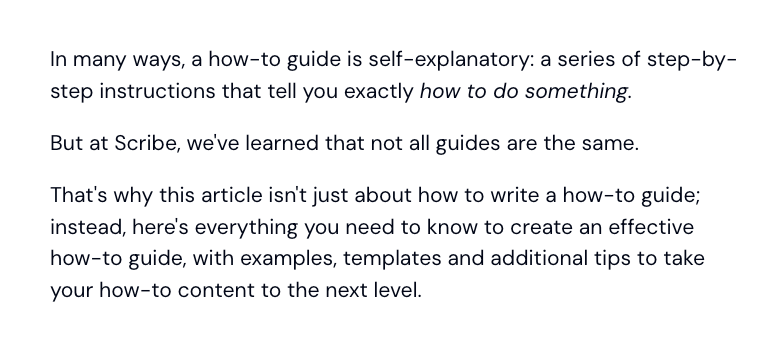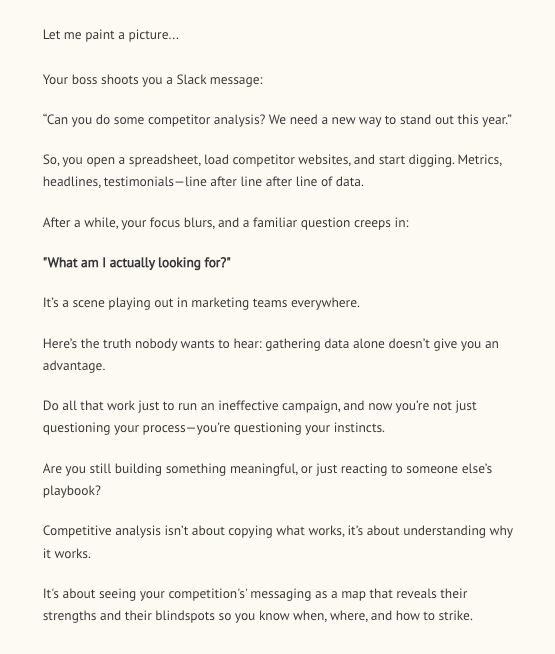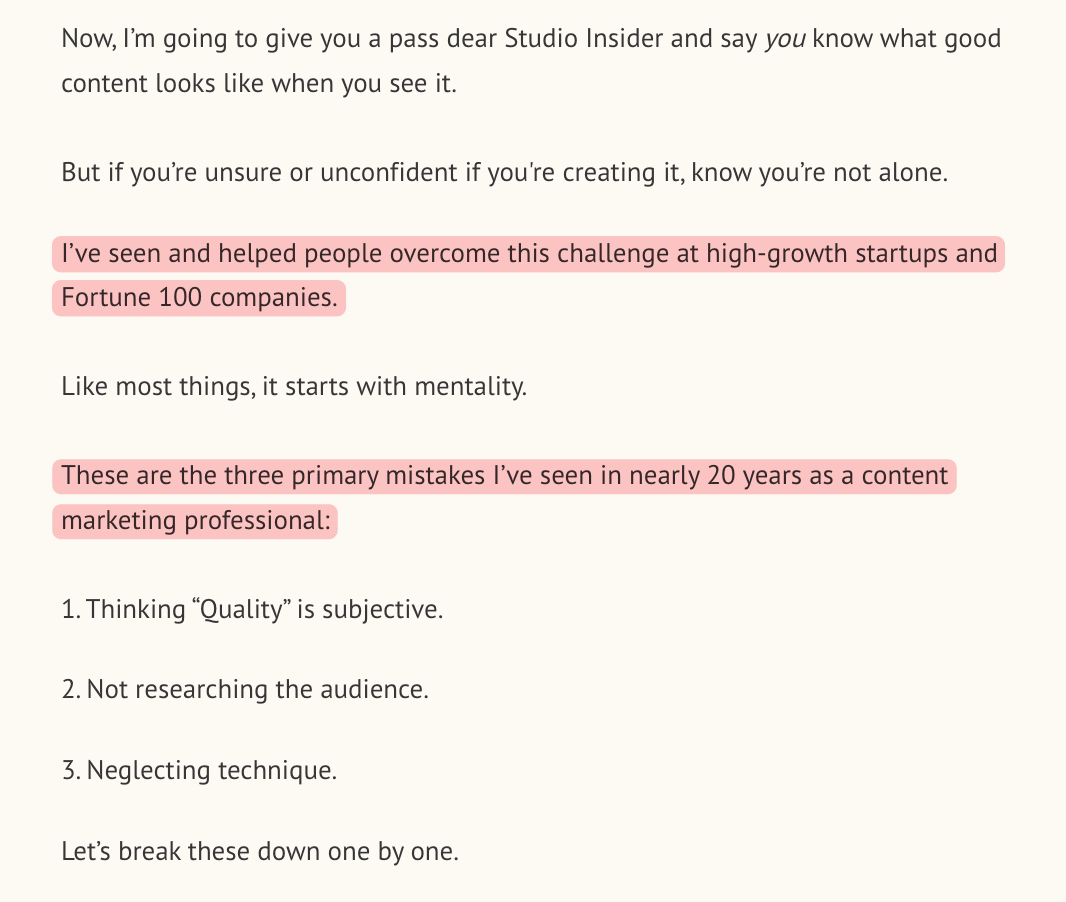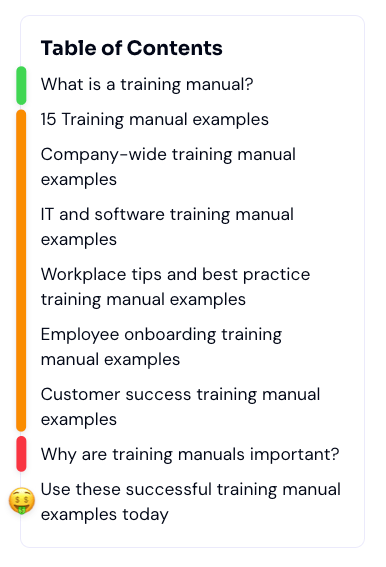- Top of the Funnel
- Posts
- Most B2B content sucks
Most B2B content sucks
Here's why – and four ways to fix yours
Create How-to Videos in Seconds with AI
Stop wasting time on repetitive explanations. Guidde’s AI creates stunning video guides in seconds—11x faster.
Turn boring docs into visual masterpieces
Save hours with AI-powered automation
Share or embed your guide anywhere
How it works: Click capture on the browser extension, and Guidde auto-generates step-by-step video guides with visuals, voiceover, and a call to action.
The problem with most B2B content?
It's fine 🤷
And fine doesn’t build brands and drive sales.
Luckily for us, I just watched Tommy Walker and Lauren Funaro turn boring to brilliant in real-time.
They took a perfectly decent B2B article and turned it into the kind of content that makes readers think “I need to work with these people.”
The crazy part? The “before” version wasn't bad. It had good stats, hit the keywords, covered the topic thoroughly.
But nobody was going to Slack it to their team.
Then Tommy and Lauren worked their magic ✨
And I took notes on their exact process so you can steal their playbook 👀
Keep reading to learn:
How to write a banger intro
How to write a scroll-stopping 'What is' section
Why you need to cut to the chase
Why "well… duh" statements are killing your writing
Let's go…
💥 How to write a banger intro
Your reader didn’t click on your article to bask in the glory of your prose.
So don’t write your intros as if they did.
“Think hook, then think ‘how can I establish the rest of this content’,” says Lauren.
Most important of all: don’t overstay your welcome.
“If you have several sentences that are long winded, people aren’t going to care,” says Lauren “You're not going to grab that person's attention, and that's your goal there.”
Here’s how Lauren does it:

Tommy’s top intro tip? Take your readers on a rollercoaster ride 🎢
The typical B2B intro goes: “this is the thing that we’re talking about.”
But there’s no energy to that.
Here’s what Tommy suggests instead:
“Start from a positive place then go into the negative, or start in a negative place and work your way into the positive. And you can start to create a rollercoaster effect.”
A couple of questions he says you can use to come up with an angle here:
What are the stakes if they don’t solve the problem?
What state of mind are they already in – and how can you charge that?
Check this out…
I’m not even the target audience for the intro to this piece from Tommy, but even I’m sweating bullets by the end of it:

👀 How to write a scroll-stopping ‘What is’ section
‘What is’[target keyword]’ sections might be going the way of bolding keywords now that AI Overviews are answering those queries in zero clicks…
But I’m still getting briefs with them in 🤷
So here’s how Lauren says you can make ‘em worth reading:
Add the “why” to your “what is” section.
So, take things from:
“Content scaling is blah blah blah.”
To:
“Content scaling is blah blah blah. Also, content scaling is super important because companies are using it to achieve [insert real-life example here].”
Tommy says another way you can level up your ‘What is’ sections is by saying:
“Here’s what the thing is. This is what it means to me.”
You see this in Tommy’s writing all the time – which is one reason it goes so hard:

🏃 Cut to the chase
The article Lauren and Tommy are going over is about seven content scaling tips.
But 349 words in (i.e. a minute and a half of reading time), Tommy notices something...
The writer still hasn’t shared any tips for scaling your content.
Are you in the habit of reading an article for a full 90 seconds before it delivers on the headline?
Or do you hit ‘back’ and go looking for something better?
Obviously, there’s a balancing act here. If you’re writing for search, you’ll probably still need to hit H2s like:
‘Benefits of [target keyword]’
‘What is [target keyword]?’
‘Types of [target keyword]’
‘Best practices for [target keyword]’
The table of contents of this article on training manual examples shows how Lauren hit those long tail keywords in the piece without losing her readers:
🟢 Explain what a training manual is so the reader is up to speed
🟠 Give the people what they want – the examples
🔴 Hit the long tail keyword after you’ve delivered on the promise of the headline
🤑 End on a product CTA

🤷 Avoid “well… duh” statements
Look, we’ve all written sentences like this one in the article Lauren and Tommy are editing:
“Scaling content creation becomes important when you want to widen your reach.”
But, well… duh 🤷
“We’re trying to give the reader a reason to really want to scale their content here so they keep reading,” says Lauren.
And how do we do that?
By replacing generic waffle with a few very specific examples.
Here’s what Lauren suggests as an alternative:
Content scaling is important to:
- Build brand recognition and exposure
- Organically capture qualified leads
- Educate potential users on how your product solves their problems
This actually shows your reader why they need to keep reading. You’re saying: “Want these good things too? Then keep reading…”
Tommy points out a compelling case study can do wonders here too. One like:
In fact, Lauren Funaro from Scribe published over 700 blog posts in a year. As a result, she increased traffic by 937%.
Btw, that thing Tommy said about Lauren and her team publishing over 700 pieces in a year and increasing traffic by 937%? They really did that – without AI 🤯
That’s actually what the bulk of this episode of The Content Studio is about.
Check it out to hear the inside story of how Lauren did that
p.s shoutout to Travis Taborek for putting this video on my radar when he shared it in TOFU 🫶
🧵 This week’s best TOFU threads
New jobs. New freelance adventures. People's businesses getting featured in the news! We’ve all been sharing our fave recent wins over in TOFU
See how TOFU members are being asked to create content to influence a brand’s appearances in LLMs
Why you should pay your freelancers on time (ft. Jafar)
 | TOFU Community Manager |
